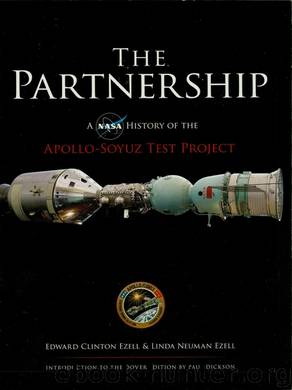Partnership by Ezell Edward Clinton; Ezell Linda Neuman; Dickson Paul & Linda Neuman Ezell

Author:Ezell, Edward Clinton; Ezell, Linda Neuman; Dickson, Paul & Linda Neuman Ezell
Language: eng
Format: epub
ISBN: 1894708
Publisher: Dover Publications
Published: 2012-10-11T04:00:00+00:00
SPACECRAFT FAMILIARIZATION
At the March 1973 Working Group meetings, Shatalov, in charge of cosmonaut training, and Bob Overmyer worked to pull together a “Crew and Ground Personnel Training Plan,” ASTP 40 700, which defined the study and practice sessions that would be held for crews, flight controllers, and other control center staff. They agreed that there would be three training sessions in the U.S.S.R. and three in the United States. Instead of trying to second-guess the curricula for the second and third meetings, they planned to let the host country advise its guest team a month or so in advance of the training agenda. Any updated material should be added to the training plan by a document change notice. The length of the meetings would be kept flexible in an effort to provide an adequate stay for the orientations but not waste time. Cosmonauts would visit Houston in July, and the astronauts hoped to travel to Star City in the fall.21
In anticipation of the familiarization visits, the Soviets lowered another barrier in their space program during June 1973—they invited a delegation of American aerospace writers to visit Zvezdny Gorodok (Star City). Donald Winston and Robert Hotz of Aviation Week and John Shaw and Jerry Hannafin of Time were among those who toured the facilities. The correspondents were impressed by the vitality of the Soviet space program. Shaw reported: “Unlike the Johnson Space Center[cp] in Houston, where major retrenchments are underway, Star City is rapidly expanding–a sure sign of the Soviet Union’s continued dedication to the exploration of space.”22 Aviation Week agreed: “The building activity underscores Russia’s determination to retain capability in manned space missions despite a series of set backs that has forced an unscheduled two-year hiatus in manned orbital flights by that country.”23 From their conversations with General Shatalov, the reporters learned that the cosmonauts were making special preparations for work with their American counterparts.
Ten cosmonauts—the ASTP crews, Yeliseyev, and Shatalov—and four Soviet training specialists arrived in Houston with the rest of the Working Groups on 8 July 1973. At the request of the Soviets, a large block of time was set aside for them to listen to taped recordings of actual Apollo air-to-ground conversations. While getting a better idea of what they would be hearing during the mission, they also reviewed the “Glossary of Conversational Expressions between Cosmonauts and Astronauts during ASTP,” which was a step toward standardizing the mission language. This work was followed by a series of video taped presentations on the command and docking modules that had been prepared by Rockwell International and narrated by Alex Sementovsky, one of Rockwell’s Russian-speaking engineers.
Each of the video lectures was followed by a question and answer period. By presenting the basic material in Russian the first time, considerable training time was saved. These tapes, covering the design and operation of the Apollo spacecraft systems, were supplemented by handouts with the same material and illustrations, and both were taken home so the cosmonauts could spend as much time with the topics as they felt was necessary.
Download
This site does not store any files on its server. We only index and link to content provided by other sites. Please contact the content providers to delete copyright contents if any and email us, we'll remove relevant links or contents immediately.
| Automotive | Engineering |
| Transportation |
Whiskies Galore by Ian Buxton(41511)
Introduction to Aircraft Design (Cambridge Aerospace Series) by John P. Fielding(32876)
Small Unmanned Fixed-wing Aircraft Design by Andrew J. Keane Andras Sobester James P. Scanlan & András Sóbester & James P. Scanlan(32559)
Craft Beer for the Homebrewer by Michael Agnew(17918)
Turbulence by E. J. Noyes(7682)
The Complete Stick Figure Physics Tutorials by Allen Sarah(7123)
Kaplan MCAT General Chemistry Review by Kaplan(6570)
The Thirst by Nesbo Jo(6422)
Bad Blood by John Carreyrou(6260)
Modelling of Convective Heat and Mass Transfer in Rotating Flows by Igor V. Shevchuk(6216)
Learning SQL by Alan Beaulieu(6013)
Weapons of Math Destruction by Cathy O'Neil(5805)
Man-made Catastrophes and Risk Information Concealment by Dmitry Chernov & Didier Sornette(5630)
Digital Minimalism by Cal Newport;(5357)
Life 3.0: Being Human in the Age of Artificial Intelligence by Tegmark Max(5167)
iGen by Jean M. Twenge(5143)
Secrets of Antigravity Propulsion: Tesla, UFOs, and Classified Aerospace Technology by Ph.D. Paul A. Laviolette(4926)
Design of Trajectory Optimization Approach for Space Maneuver Vehicle Skip Entry Problems by Runqi Chai & Al Savvaris & Antonios Tsourdos & Senchun Chai(4833)
Electronic Devices & Circuits by Jacob Millman & Christos C. Halkias(4731)
